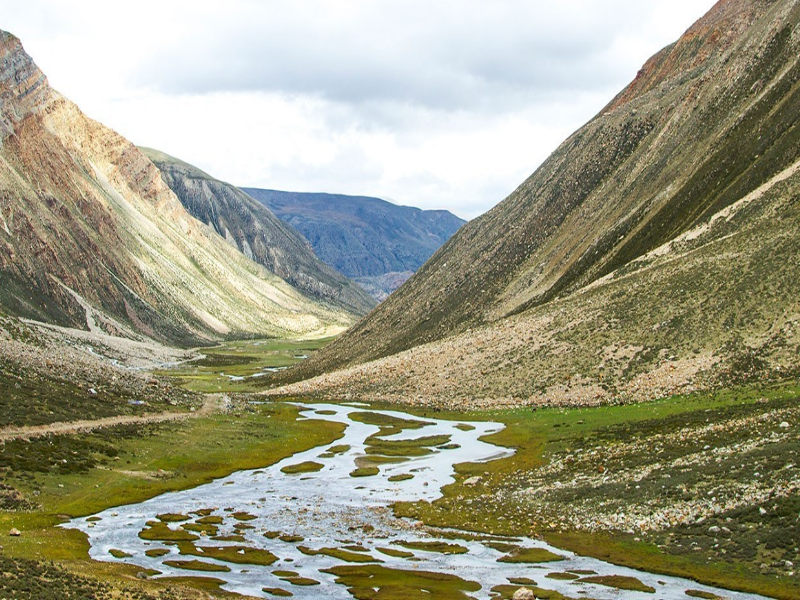
Humla Limi Valley Trek
Tour Gallery
Overview
Humla Limi Valley Trek
Nestled amidst the majestic peaks of the Himalayas lies the enchanting Humla Limi Valley Trek, a hidden gem in the northwestern corner of Nepal. This remote and untouched region offers intrepid adventurers a journey through breathtaking landscapes, ancient Tibetan culture, and unparalleled tranquility. As one of Nepal’s best-kept secrets, the Humla Limi Valley Trek promises an unforgettable experience for those seeking an off-the-beaten-path adventure.
Getting There and Out
Embarking on the Humla Limi Valley Trek is a journey that begins with reaching the starting point. The primary gateway to this remote region is through Nepal’s capital, Kathmandu. From Kathmandu, adventurers typically take a domestic flight to Nepalgunj, a bustling city in the western region of Nepal. Nepalgunj serves as the initial transit point before travelers proceed to Simikot, the district headquarters of Humla.
From Nepalgunj, a scenic flight transports trekkers to Simikot, offering breathtaking views of the Himalayas along the way. However, due to weather conditions, flights may occasionally be delayed or canceled, so it’s advisable to plan for potential changes in the itinerary. Upon arrival in Simikot, trekkers may need to obtain necessary permits from the local authorities before commencing their trek into the Humla Limi Valley.
For the return journey, trekkers typically follow the same route in reverse, flying out of Simikot back to Nepalgunj before continuing their onward journey. It’s essential to factor in buffer days for potential flight delays and make travel arrangements accordingly to ensure a smooth transition in and out of the region. Additionally, staying flexible with travel plans can help mitigate any unforeseen challenges and ensure a memorable adventure in the Humla Limi Valley.
Best Time to Trek Humla Limi Valley
The ideal time to embark on the Humla Limi Valley Trek is during the spring and autumn seasons, which span from March to May and September to November, respectively. These months offer the most favorable weather conditions, with clear skies, mild temperatures, and minimal rainfall, ensuring optimal trekking conditions for adventurers.
During the spring season, the valley comes to life with vibrant blooms of rhododendrons and other wildflowers, creating a picturesque backdrop against the towering Himalayan peaks. The moderate temperatures make for comfortable trekking experiences, allowing travelers to fully immerse themselves in the natural beauty of the region.
Similarly, the autumn months offer crisp, clear days and stunning views of the surrounding mountains, making it an ideal time for trekking in the Humla Limi Valley. The post-monsoon period brings lush greenery to the landscape, enhancing the scenic beauty of the trekking trails.
It’s essential to note that weather conditions in the Himalayas can be unpredictable, and occasional rain or snowfall may occur even during the peak trekking seasons. Therefore, it’s advisable to check weather forecasts and be prepared for changing conditions, especially when trekking at higher altitudes. Additionally, the winter months from December to February are generally not recommended for trekking in the Humla Limi Valley due to heavy snowfall and extremely cold temperatures.
Humla Limi Valley Trek Permit Cost
Before embarking on the Humla Limi Valley Trek, it’s essential to obtain the necessary permits, as the region falls within a restricted area of Nepal. The primary permits required for this trek are the Restricted Area Permit (RAP) and the TIMS (Trekkers’ Information Management System) card.
The cost of the restricted area permit varies depending on the season and duration of the trek. As of the latest information, the permit fee for the Humla Limi Valley Trek ranges from USD 10 to USD 50 per person per week, with an additional fee for each extra day beyond the initial week. The exact cost may be subject to change, so it’s advisable to check with the local authorities or trekking agencies for the most up-to-date information.
In addition to the Restricted Area Permit, trekkers are also required to obtain a TIMS card, which helps ensure their safety and provides valuable information to authorities in case of emergencies. The TIMS card costs around USD 20 for individual trekkers and USD 10 for trekkers organized through registered trekking agencies.
It’s important to budget for permit costs as part of the overall trekking expenses and to ensure compliance with local regulations. Obtaining the necessary permits in advance will help avoid any last-minute complications and allow trekkers to focus on enjoying the incredible landscapes and cultural experiences of the Humla Limi Valley.
How Difficult Is the Humla Limi Valley Trek?
The Humla Limi Valley Trek presents a moderate to challenging level of difficulty, offering adventurers an exhilarating journey through rugged terrain and high-altitude landscapes. While the trek is suitable for trekkers with a moderate level of fitness and previous trekking experience, it does require a certain level of physical endurance and mental resilience due to its remote location and varying altitudes.
The trek involves traversing diverse terrain, including rocky paths, steep ascents, and occasional river crossings, which can pose challenges to even seasoned trekkers. Additionally, the high altitude of the region, with elevations reaching up to 4,000 meters or more, can lead to altitude-related symptoms such as shortness of breath, fatigue, and headaches.
Trekkers need to acclimatize properly to the altitude by allowing sufficient time for their bodies to adjust to the reduced oxygen levels. This may involve incorporating rest days into the itinerary and ascending gradually to higher altitudes. Adequate hydration, proper nutrition, and pacing oneself are also crucial for minimizing the risk of altitude sickness and ensuring a safe and enjoyable trekking experience.
While the Humla Limi Valley Trek presents its challenges, the breathtaking landscapes, cultural encounters, and sense of accomplishment make it a truly rewarding adventure for those willing to take on the journey. With careful preparation, including physical training, altitude acclimatization, and a positive mindset, trekkers can conquer the challenges of the trek and create unforgettable memories amidst the Himalayan wilderness.
Conclusion
In conclusion, the Humla Limi Valley Trek stands as a testament to the raw beauty and cultural richness of the Himalayan region. From the moment trekkers set foot on the trail, they are greeted with awe-inspiring landscapes, ancient traditions, and a sense of adventure that permeates every step of the journey.
As trekkers navigate the rugged terrain and ascend to higher altitudes, they are rewarded with panoramic views of snow-capped peaks, lush valleys, and pristine forests. Along the way, encounters with local communities offer insights into the centuries-old Tibetan culture, characterized by vibrant festivals, intricate monasteries, and warm hospitality.
Despite the challenges posed by the remote location and varying altitudes, the Humla Limi Valley Trek is a testament to the human spirit’s resilience and determination. With proper preparation, including physical training, altitude acclimatization, and a positive mindset, trekkers can conquer the challenges of the trek and create unforgettable memories amidst the Himalayan wilderness.
In the end, the Humla Limi Valley Trek is more than just a physical journey. It is a transformative experience that nourishes the soul and fosters a deeper connection with nature and oneself. Whether seeking adventure, cultural immersion, or spiritual enlightenment, this trek offers something truly special for every traveler brave enough to embark on the journey.
Trip Highlights
The Humla Limi Valley Trek is a journey filled with awe-inspiring highlights that captivate the senses and leave a lasting impression on trekkers. From majestic mountain vistas to ancient cultural heritage, this remote region of Nepal offers a multitude of unforgettable experiences.
One of the most remarkable highlights of the trek is the opportunity to witness the breathtaking beauty of the Himalayas up close. As trekkers traverse through the valley, they are treated to panoramic views of snow-capped peaks, including the towering Mount Kailash and Mount Saipal, which dominate the skyline with their majestic presence.
The trek also provides a unique opportunity to immerse oneself in the rich cultural heritage of the region. Along the trail, trekkers encounter traditional Tibetan villages, where they can interact with local communities and learn about their way of life. From ancient monasteries adorned with colorful prayer flags to centuries-old chortens and mani walls, the cultural landmarks along the trek offer insights into the spiritual and cultural traditions of the Tibetan people.
Another highlight of the Humla Limi Valley Trek is the chance to explore the pristine natural beauty of the region. Trekkers meander through lush forests, cross crystal-clear mountain streams, and camp beneath star-studded skies, surrounded by untouched wilderness. The tranquil ambiance of the valley provides a perfect escape from the hustle and bustle of modern life, allowing trekkers to reconnect with nature and rejuvenate their spirits.
Overall, the highlights of the Humla Limi Valley Trek combine to create a truly unforgettable adventure, offering trekkers a unique blend of natural beauty, cultural heritage, and spiritual serenity. Whether marveling at the towering Himalayan peaks or immersing oneself in the tranquility of the remote valley, this trek promises an experience of a lifetime for those willing to embark on the journey.
What's Included
Included Services
- ✓Best available hotels/lodges/guesthouses on a twin/double sharing basis in Nepalgunj, Simikot, and Dharapuri
- ✓Tented Camp accommodations on a twin-sharing basis throughout the trek
- ✓All necessary tents, kitchen equipment, and camping gear for the trek
- ✓Professional & experienced English-speaking trekking guide
- ✓All meals (Main course- breakfast, lunch & dinner with tea/coffee) during the trek
- ✓Sleeping bag, Down jacket (if required)
- ✓Accommodation, Meals, wages, allowances, insurance, Medical, and equipment for Himalayan trekkers’ Trekking Guide and the supporting crew
- ✓All required Permits
- ✓All applicable government taxes
Excluded Services
- ✗International Airfare
- ✗Nepal Visa fee
- ✗Meals in Kathmandu
- ✗Personal Expenses e.g. phone calls, laundry, bar bills & extra porters
- ✗Travel Insurance
- ✗Tips for Guide and Porter
Detailed Itinerary
More Information
What are the accommodation and dining options available during the trek?
Accommodation along the Humla Limi Valley Trek ranges from basic tea houses to camping. Tea houses offer dormitory-style rooms and communal bathrooms. Meals include local Nepali dishes. Trekkers may need to bring sleeping bags for camping.



